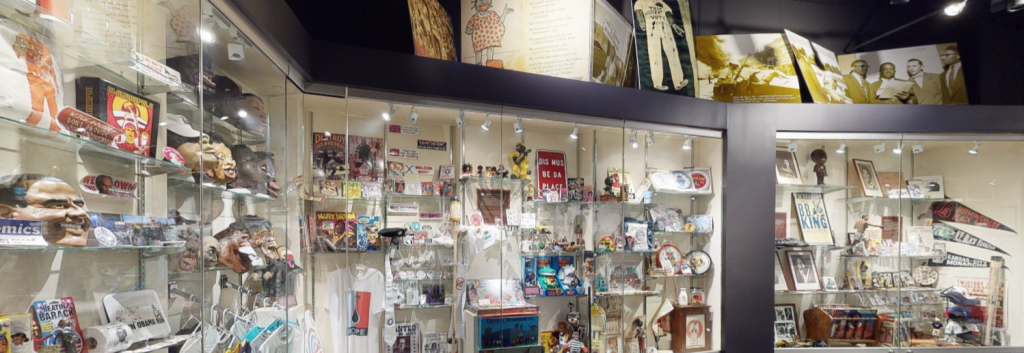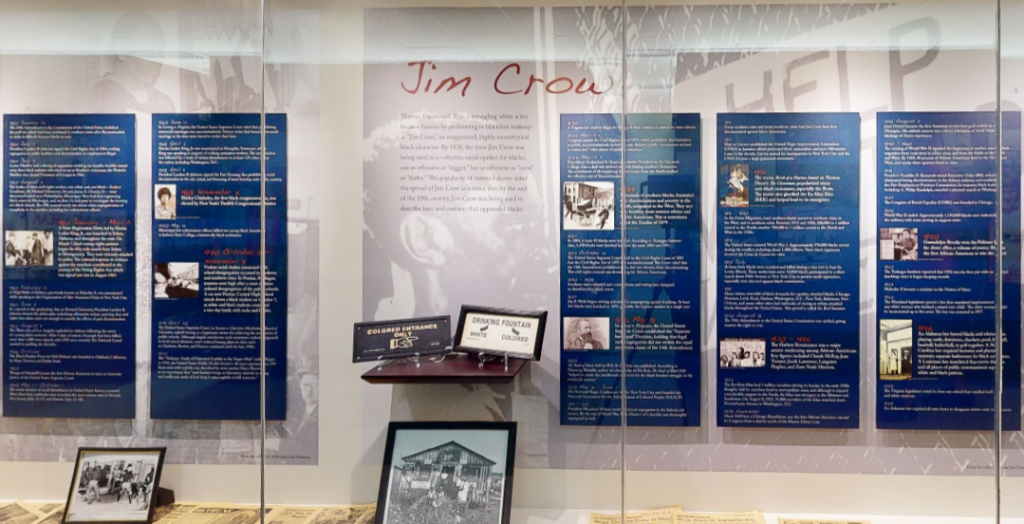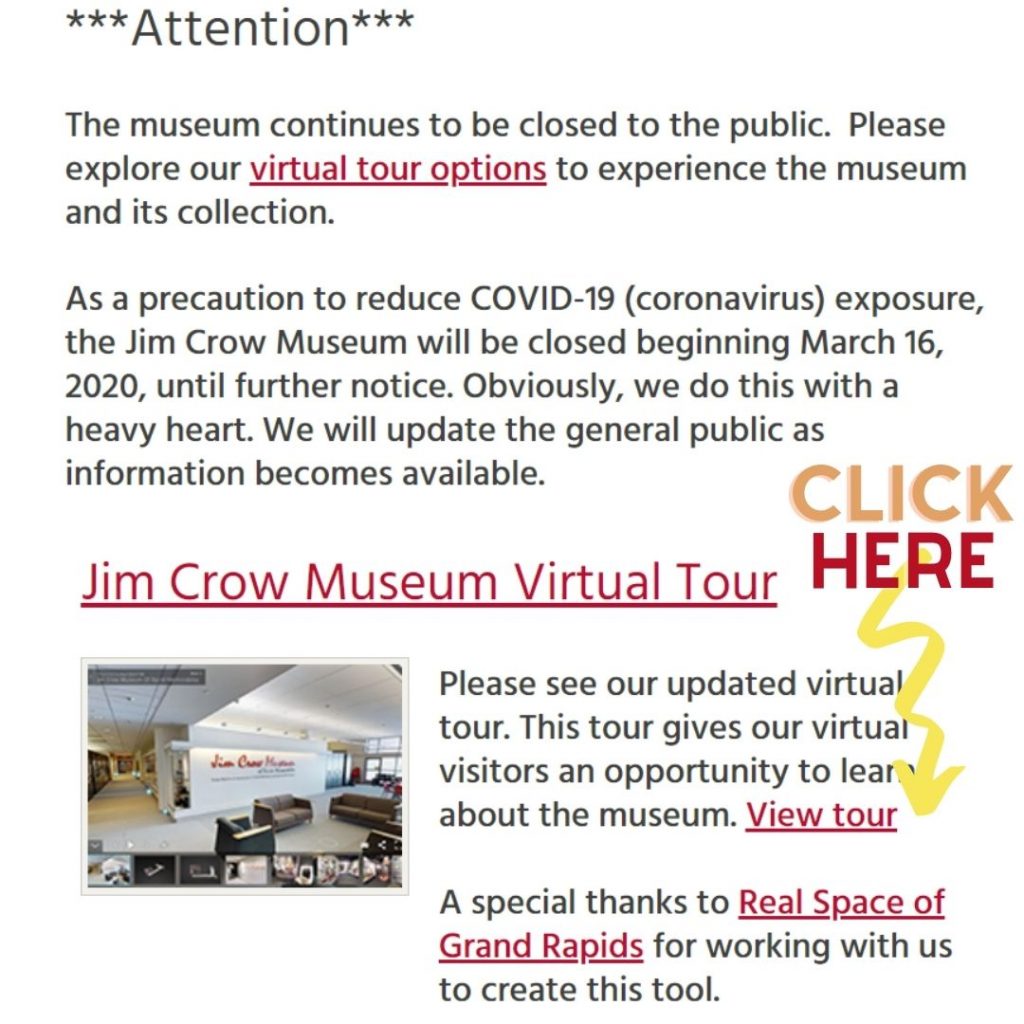
Ferris State University in Big Rapids, Michigan has a museum exhibition entitled “The Jim Crow Museum of Racist Memorabilia” that is now online for people of all ages in all locations to explore and enjoy. This exhibition, curated by Dr. David Pilgrim, is dedicated to the display of historical items from the era of Jim Crow to “teach tolerance and promote social justice” within this volatile socio-political climate.
The mission of the exhibition is to “use objects of intolerance to teach tolerance and promote social justice.” This exhibition contains over 10,000 pieces that envelope the visitor in the history, samplings of which are placed in traveling exhibitions such as “Hateful Things,” which has also been made available for online viewing. The fact that this exhibit is incredibly accessible online, engaging, and exceptionally informative demonstrates that the target audience is actually quite broad! This exhibit is geared towards anyone who wants to learn about the Jim Crow Era and the impact that it had on American society, as one of their mission objectives is to “serve as an educational resource.” Moreover, they allow the visitor to visualize what life was like under Jim Crow segregation by surrounding them with historical items, not allowing them to escape their presence until the end of the exhibition, which is rather metaphorical.
When addressing topics like racism in America, it can be quite difficult to have a conversation that is completely devoid of bias, whether it be “good” or “bad.” In the case of this exhibition, I believe the bias towards social justice and antiracism is absolutely necessary, or else it would defeat the purpose of it.

The exhibit is so expansive and so full of artifacts that it sheds more light on just how encapsulating Jim Crow was, how it was present in every aspect of life. Everyone sees the signs on the bathrooms and above the water fountains in their high school textbook, but due to the sheer number of artifacts, the viewer may see things they have never seen before (or that evoke memories if they were alive during this time period). It is a thought-provoking, emotional experience to “walk” through the exhibit and see these things.
Segregation was made illegal in 1964 and Black people were given the right to vote in 1965. As a society, we must realize and remember that we are not so far removed from the era of Jim Crow. Black people still face heavy oppression, systemic and regional racism, disenfranchisement, and disproportionate amounts of violence. We have to do better and we must make great strides to be better. This is why this exhibition is so important – in order to transform our future, we must examine the pitfalls and failures of our past.
I argue that we need more museum exhibitions like this one that force people to confront past narratives that might make them uncomfortable. It is my belief that if you are studying history and there is not a single point along the timeline that makes you angry or uncomfortable, you need to take a look inward, take a swim in Lake You, and think about your privilege.
“Our ignorance of history causes us to slander our own times.”
Gustave flaubert, novelist
Let’s Take A Tour
The virtual tour of this exhibition offers the visitor a panoramic, self-guided walkthrough. When you first visit the link for the exhibit, you are given directions on how to tour the exhibit – the up and down arrows on your keyboard will move you forwards and backwards, the left and right arrows will rotate you either left or right, and the plus and minus keys will enable you to zoom in or out. You do have the option to scroll through, but it is a little clunkier that way. It is much easier to just use the keyboard; it is much smoother in terms of visuals, as everything is less blurry when you move.

Once you get the hang of using the arrows on your keyboard, the exhibition is incredibly easy to navigate. Although, it is also rather easy to get turned around/”lost.” To remedy this, there is a “play” button in the bottom left corner that will take you back to the beginning of the virtual tour that you can pause any time and start maneuvering on your own again. There is also an option to view the “dollhouse,” which is a 3-D layout of the exhibition that you can click into if you lose your place. The exhibit is self-directed, but you can use the aforementioned layout maps if you would like to follow a set path, as there are some areas in which you can choose the direction you go, like a fork in the road. The virtual tour works well and accomplishes what it needs to accomplish, but it does take a minute or two to get used to it if you are unfamiliar with this type of online exhibit.
This video is a tour of The Jim Crow Museum of Racist Memorabilia hosted by its curator, Dr. David Pilgrim. It is not a tour of the entire exhibit. In this video, Dr. Pilgrim discusses some of the major themes that occur throughout the exhibit.
Let’s Talk Design


This is the second display that you will see once you begin the virtual tour. As you can see, there are a handful of objects and text behind them . If you click on the red “target,” a timeline of slavery in America will pop up that you can expand to full screen and check out. If you click on the blue “target,” a video will pop up that you can expand to full screen. This video is a narration of all the text behind the artifacts (since you cannot read the text if you zoom in – it gets really blurry).
If one does want to utilize the red timeline pop-ups, one does have to start at the beginning of the exhibit, as each pop-up is a different section of the timeline. (This is only seen in the first few displays.) The blue narration targets are specific to each display and are seen throughout the entire exhibition. This is incredibly helpful, as the text always adds something special to the exhibit. As you proceed through the exhibit, the number of artifacts in each display increases and the amount of text decreases, but there is still a small amount of text in each display to tie everything together and elaborate on the theme of the display. The hallway leading into the main hall (as mentioned below) is well-captioned and every bit of text supplied is absolutely necessary in telling the story of Jim Crow in America.


The first part of the exhibit takes you down a hallway, then you move through a set of double doors into the main hall of the exhibit. The wall color changes from a light beige/white to a navy blue and the carpeting changes from a light beige to a grey, which allows the more colorful artifacts to pop and have more attention drawn to them, as the lighting plays off of the darker wall and flooring. The text is either displayed on a white, blue, or red background, and is always a contrasting color and in a large enough size so that it is easy to read (in person).

Hallway Display 
Main Hall Display
Thousands of the artifacts that are on display at The Jim Crow Museum of Racist Memorabilia were donated by Dr. David Pilgrim in the 1990s. The exhibit uses a variety of different artifacts that include but are not limited to the following: photographs, signage, dolls and statues, Halloween masks, and children’s toys.
If you’re visiting the exhibit through the Ferris State University website, the virtual tour could be a little tricky to find if you do not know what you are looking for. Once you make it to the website for The Jim Crow Museum of Racist Memorabilia, the tour is very easy to find.

If you wanted to schedule a virtual tour with a guide, you would click the red text that says “virtual tour options.”
Overall, I think that this exhibit is incredible. The sheer number of artifacts that it contains is its greatest strength and its greatest weakness. It allows for people to see items that they may have never seen or heard of before, thereby drawing attention to how Jim Crow racism was applied to every aspect of society. There are over 10,000 artifacts just in this exhibition that overwhelm the viewer as they enter the main hall, which mirrors how overwhelming Jim Crow racism was and how it enveloped every single person, no matter their race. Although, this does have its disadvantages. It is absolutely impossible to see all of the items in a single viewing. There is simply too much information to be processed at one time. An improvement that I would suggest would be to decrease the number of artifacts on display and increase the number of traveling exhibits to draw more attention to this museum exhibition. Although, since this collection of artifacts is the brainchild of Dr. David Pilgrim, I am reticent to say anything negative (though I could not say anything more negative than I already have).
To Learn More


If you would like to learn more about Dr. David Pilgrim and his collection of Jim Crow artifacts, you can check out his books Understanding Jim Crow: Using Racist Memorabilia to Teach Tolerance and Promote Social Justice and Watermelons, Nooses, and Straight Razors: Stories from the Jim Crow Museum
Below I have linked another article and video, as well as a pdf version of an interview with Dr. David Pilgrim, if you would like to check them out!
Interview-with-Dr.-David-Pilgrim
Leave a Reply